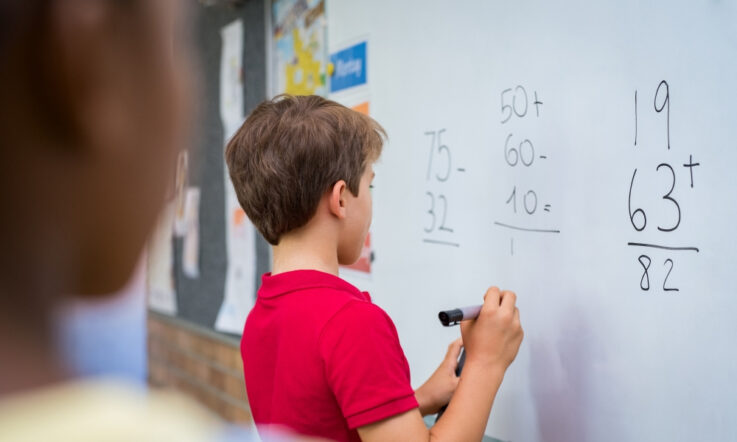This podcast from Teacher magazine is supported by EnhanceTV. EnhanceTV streams the best curriculum-linked movies, documentaries and TV shows Australian television has to offer. Use the word ‘teacher' in the promo code at sign-up and receive an ongoing free teacher account. Subscribe free at enhancetv.com.au today.
From Teacher magazine, I'm Rebecca Vukovic, and you're listening to an episode of Teacher Staffroom, where we catch you up on the latest evidence, insight and action.
The content published on Teacher magazine this month has been packed full of contributions and insights from those working in the education community – from teachers and school leaders, to researchers, education consultants and university academics. I'm always blown away by the wealth of knowledge and expertise that we're able to share with you, our readers and listeners. In today's episode, I'm going to whip through the contributions we've published, giving you some snippets to come from the articles, videos and columns. I'll also share some insights from the three podcasts we published this month – one on creativity, another on leadership coaching and one that explores co-creating bullying policies. If you're an avid listener of Teacher Staffroom, you'll know that this series was created to bring people together and to support collaboration between colleagues. We pose questions throughout every episode so we'd encourage you pause the audio, gather some colleagues and discuss together how these stories could be relevant to your school context. Let's get started.
The first piece is a contribution from Omar Jamal, Head Teacher at Al-Faisal College in Sydney, that explores how developmental rubrics have improved student learning. In his piece, Omar shares this story:
Almost immediately after receiving their assessment tasks back, one of my students asked, “Where did I lose my marks?” while another proclaimed, “Why did I only get 10/20!?” It felt as though they had completely dismissed the endless hours that went into writing individual feedback. During my initial years of teaching, this was a common occurrence in my Year 12 Business Studies classes. Students' questions made it apparent that they were still confused about the next steps in their learning. It seemed that they were so blinded by their marks, that they ignored the written feedback.
In the piece, Omar shares how he discovered the developmental approach, how he and his colleagues created and began using developmental rubrics, and how it shifted student conversations.
Here's something to consider:
Think about your own students: Do they understand where they are in their own learning and what the next steps are? Do you already use assessment rubrics? Do you discuss these rubrics with students at the outset to ensure they understand the task expectations? Have you shared and discussed samples of previous student work as a reference point?
Moving on now, the next contribution I'd like to highlight was co-written by Luke Willsmore, Head of Secondary at Emmaus Christian School in the ACT and Dr Tanya Vaughan and Susannah Schoeffel from Evidence for Learning. They explore how Emmaus Christian School moved to a new model of classroom integration for Teaching Assistants and discuss the research that informed the change process.
It's a fascinating piece where the authors clearly outline the impetus for change and how they implemented a new way of working. If you're interested in reading the full piece, I'll link to it (and all the articles I mention in this episode) in the transcript of the podcast at teachermagazine.com.au
Another recent contribution was from Nick Brooking, Head of Mathematics at Peace Lutheran College in Far North Queensland. Nick has been investigating strategies to reduce exam anxiety among his students – the first cohort to face Queensland's new external examinations. In this piece, Nick shares some of the key strategies he's implemented and some of the feedback from students. Here's a quote from the article that explores that impact:
Before undertaking these actions to reduce students' exam anxiety, I expected there to be a small but worthwhile impact. Having recorded students' reported anxiety/stress levels before and after these actions were taken, I am surprised by the size of impact that students have reported and now consider it to be a worthwhile practice to implement with all of my classes.
Here are some questions to think about, and discuss with your colleagues.
What strategies do you employ to help reduce exam stress in your students? Have you asked for feedback on the effectiveness of these strategies from a student point of view?
The author of this article is encouraging students to celebrate both their successes and challenges. Think about your own students: are they fearful of making mistakes, or do they see them as opportunities to learn?
Another contribution I'd recommend reading comes from Dr Keith Mason and Dr Jason DeHart. In their piece, they trace the way Costa and Kallick's 16 Habits of Mind might take shape in a literacy-focused classroom and explore ways that we can use them with students as they learn about literacy and language.
Another great piece explores collaborative, reflective practice. It's written by Kate Alexander, Program Leader - Collaborative and Reflective Practices at Villanova College in Brisbane. In the short piece, Kate explains how the Collaborative and Reflective Practices Program at Villanova College aims to improve teaching practice by bringing teachers together, to allow them to collaborate and discuss the impact they have on students, and implement new strategies with the support of their peers.
You'll also notice that regular video contributor, Holly Millican from South Grafton High School is back this month, with a new video on how to engage students during the period of remote learning. Holly shares three activities that she found useful to use with her students, to keep them both engaged and accountable while learning from home. You'll find the link to the YouTube clip in the transcript of this episode.
And finally, before I move onto podcasts, I'd like to remind you that a new report from the Programme for International Student Assessment (or PISA) was released this month that explores students' experiences at school and how they relate to student performance. Teacher columnists, Andreas Schleicher from the OECD and Dr Sue Thomson, Deputy CEO of Research at ACER, both wrote about this new report in their latest columns.
Okay, let's chat about podcasts.
Earlier this month I sat down with Professor David Cropley from the University of South Australia to delve into his research into whether any specific differences exist between creativity in the Arts and creativity in STEM. The study he conducted surveyed over 2000 undergraduate students enrolled in STEM courses and in Arts courses, to explore how creativity differed across the disciplines. In the Research Files episode we recorded, David takes me through how they conducted the study, some of the key findings, and the practical implications of this research for educators working in the K-12 space.
Here's a short excerpt from the interview where David is discussing making creativity a habit in the classroom.
And there are three things when we think of creativity as a habit, there are three things that are necessary that I just mentioned – opportunity, encouragement and reward. So as we embed creativity across the curriculum, if we take that concept of creativity as a habit, as a kind of guiding principle, and the need for the opportunity to be creative across different subjects, and then when children in the classroom show that they're making use of those opportunities, that they get the encouragement, and when they do things that are actually creative, that they get some kind of recognition and reward – that's the essence or it's the first important step in fostering creative capabilities at the school; this idea that it's a habit, that kids need opportunity, encouragement and reward, and that it's really the job of the teachers to sort of guide that and create that. And what the teachers do in the classroom themselves, of course, is as important as what's in the curriculum. So the teachers are also constantly demonstrating what it looks like for a person to be open to new ideas and flexible and able to think divergently and so on.
That was David Cropley there, here's something to think about:
David says there are three necessary things to make creativity a habit – opportunity, encouragement and reward. How do you provide opportunities for students to be creative across different subjects? When students make use of these opportunities, what encouragement do you offer them? And, when students do things that are creative, do you give them any kind of recognition or reward?
The next podcast we published was a School Improvement episode on developmental leadership coaching. Principal Karen Snibson from Phoenix P-12 Community College in Victoria and leadership coach Angela Mina have been working together as part of the two year Menzies School Leader Fellowship Program. This episode explores increasing collective efficacy and how developmental leadership coaching differs from an approach that school leaders may be used to.
Here's a short clip of Karen Snibson explaining how working with a leadership coach helped her to build collective efficacy in her school.
In working with Angela what really I needed to create a shift on was empowering the other leaders in my school to really embrace their role in leadership; for me to model some vulnerability, increase trust and to really then be asking them to be doing the same thing. So, actually looking at the leaders in our team, empowering them to grow more, to step in more, to be vulnerable and to be really active in the innovation space and knowing all the time that they have my support to do that.
Here's something to consider:
As a school leader, what would be the one big thing that you would shift and grow in yourself in order to grow collective efficacy in your school? What steps would you need to take? How would you need to grow as a leader?
And the final podcast I'd like to share with you is from our series on Behaviour Management. Editor Jo Earp sat down with Dr Lesley-anne Ey, a Senior Lecturer at the University of South Australia. Lesley-anne and her UniSA colleague Professor Barbara Spears have been working with early childhood teachers to identify problems with bullying in their own school context and co-design tailored education and prevention programs. In the episode they discuss early childhood intervention, the Participatory Design method, and the feedback from the teachers and schools involved.
Here's a short clip from the podcast, it's Lesley-anne discussing one school's lack of awareness of bullying policies and procedures, and the impact this has on staff.
There was one particular school where there were several educators that didn't know that they had a bullying policy and procedure, so that sort of indicates that it's not a topic of conversation – it's not shared, teachers aren't being made aware of the policy and procedure, how to access that and what they need to do in relation to policy and procedure. We did find through interviewing teachers about this that quite a lot of bullying incidents sort of got ‘passed up the line'. So, if there was an incident that a teacher thought might be bullying it then went to the school counsellor or the deputy principal, it wasn't managed by the teachers. And that was detrimental, to some degree, because teachers weren't learning about bullying, they didn't have a clear understanding themselves about what bullying was, how to define bullying, and also how to manage that, how to respond to that.
Let me leave you with something to think about. What bullying policies and procedures are in place at your school? Who was involved in drawing them up? Is the language suitable for all ages, including your youngest students? And, are all staff aware of these policies and procedures?
That's all from me today, and you're all caught up on the latest evidence, insight and action. I'll place links to all the content and resources in the transcript of this episode, which you'll be able to find under the podcast tab at our website teachermagazine.com.au
This podcast from Teacher magazine is supported by EnhanceTV. EnhanceTV streams the best curriculum-linked movies, documentaries and TV shows Australian television has to offer. Use the word ‘teacher' in the promo code at sign-up and receive an ongoing free teacher account. Subscribe free at enhancetv.com.au today.



